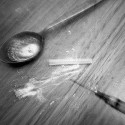With anti-addiction pill, ‘no urge, no craving’
A no-frills bar called Goober’s, just north of Providence, Rhode Island, is probably the last place you’d expect to find a debate over cutting-edge addiction therapy. But this is where Walter Kent, a retired mechanic, spends his Fridays. He helps in the kitchen and hangs out in the bar, catching up with old friends.
Most addiction specialists would call this playing with fire, or worse. That’s because for more than 30 years, Kent was a hard-core alcoholic. His drinks of choice were Heineken beer and Jacob Ginger brandy, but anything with alcohol would do.
“It’s like a little kid wanting a piece of candy. You see it, you want the taste of it.” He closes his eyes and sniffs the air, remembering the feeling. “You can be by yourself, and all of a sudden get even a hint of alcohol, just the smell of it, and say, ‘Oh, I need a drink.’ That sensation is not something you can get rid of.”
But today, Kent isn’t tempted in the least. He says the credit goes to a prescription medication — a pill called naltrexone. It’s part of a new generation of anti-addiction drugs that may turn the world of rehab on its head.
Dr. Mark Willenbring, who oversees scientific research at the National Institute on Alcoholism and Alcohol Abuse, says alcoholism has reached a point similar to one depression reached 30 years ago — when the development of Prozac and other antidepressants took mental health care out of the asylum and put it in homes and doctors’ offices.
“There will be a ‘Prozac moment,’ ” Willenbring says, “when primary care doctors start handling functional alcoholics.”
Among the findings that are causing excitement:
• A study led by Dr. Bankole Johnson of the University of Virginia found that topiramate (Topamax) — already used to treat epilepsy and migraines — reduced the number of days on which alcoholics drank heavily, by 25 percent more than among alcoholics who got just therapy.
• A federally funded study known as COMBINE compared cognitive-behavioral therapy alone with therapy along with naltrexone. Patients receiving both were more likely to stay abstinent and drank less if they did relapse.
These findings highlight what’s become increasingly clear: Addiction is a brain disease, not just a failure of willpower. Naltrexone and topiramate have slightly different mechanisms, but both seem to block the release of brain chemicals that are linked to pleasure and excitement. Unlike earlier drugs used to treat alcoholics, neither is addictive or carries significant side effects. It does appear that each might work better in certain subgroups — topiramate for repeat relapsers, and naltrexone in people with a strong family history of alcoholism.
Johnson is a paid consultant to the company that makes Topamax, but his study appeared in the Journal of the American Medical Association and he says other medications can also work well. “I think everybody who’s an alcoholic should be given medication if they’re willing to take it,” he says. “It’s been shown over and over with research studies that effects of medicine are over and above that of therapy. And if you’re not getting the medicine, it’s a bit like having one hand tied behind your back.”
Before he found naltrexone, Kent had tried to quit drinking more times than he can remember. “I was the kind of person who only drank if he was alone or with somebody. Other than that, it was never a problem,” he jokes now. He did two stints in residential rehab programs and went to countless AA meetings, but nothing worked. Kent is a giant of a man — he stands a broad-shouldered 6 feet 5 inches tall, and has two sons who played professional basketball in Israel — but for most of his life, he couldn’t find the strength to put down the bottle.
It got worse in 2000, after an injury from falling off a ladder forced him to stop working. Depressed and in pain, with time on his hands, Kent began boozing from 8 o’clock in the morning, every morning. It went on a few months until his wife, a woman he’d known since grammar school, handed him an ad from a newspaper and an ultimatum: “She said, ‘You’re killing the marriage, and you’re killing yourself,’ ” Kent said. ” ‘ Get help or I’m gone.’ ”
The ad was recruiting alcoholics for research at Roger Williams Hospital, part of Brown University. Kent signed up. It was part of the COMBINE study. Kent got 16 weekly visits and also something most addicts never hear about: medication. This time, he stayed sober, even after his doctor took him off naltrexone. That was more than eight years ago.
Despite studies showing effectiveness, established rehab programs have been slow to adopt the use of medication. At Hazelden in Minneapolis, Minnesota, a small proportion of patients receive anti-addiction drugs, but medical director Dr. Kevin Clark says the traditional model — based on intensive therapy and the 12 steps popularized by Alcoholics Anonymous — is still best. “It is a disease of the brain, but it’s a multifaceted disease. It has a spiritual component, a behavioral component to it,” says Clark. “Our experience tells us that having the network of support and recovery is what really makes the difference.”
John Schwarzlose, executive director of the Betty Ford Center, echoes that but takes a more stringent approach. No patients at Betty Ford receive anti-addiction drugs as part of treatment, although a handful of long-time addicts may be referred to a prescribing physician once their stay is over. “Where we battle with [the National Institute on Alcoholism and Alcohol Abuse] is when they say we have trials of a new drug, and then proclaim this is a treatment for alcoholism,” says Schwarzlose. “They’re smart people, but they’re missing how complex this disease is.”
Schwarzlose argues that Willenbring and Johnson are using the wrong measure of success. He says abstinence is the only true measuring stick — that an alcoholic who is drinking less is just at a way station on the road to relapse. “Naltrexone has reduced drinking, but once you’re addicted, there is no such thing as ‘OK’ drinking. This is one of those cases where there’s a real schism between the research and actual practice.”
This attitude frustrates Willenbring, who estimates that in the United States only one addict in 10 has even heard about medication options. “In most cases, the treatment is entirely nonmedical. Most people are not even told about the medications that are available for treating alcohol dependence, and I think that’s a crime.”
Still, medication is slowly creeping into mainstream addiction therapy. One big advocate is Percy Menzies, a pharmacist and former sales representative for DuPont, which developed naltrexone. His St. Louis, Missouri-based Recovery Centers for America treats patients in an on-site hospital, then refers them to outside physicians for follow-up treatment. Along with therapy, virtually every patient is given Vivitrol, a long-lasting form of naltrexone that’s given monthly by injection.
Kent says naltrexone saved his life. When the COMBINE program was over, Kent’s doctor told him to call if he felt the old need for a drink coming back. But it never came. “I have yet to go back and say, ‘I have an urge for a drink,’ ” says Kent, lounging in Goober’s. “[My friends] will offer, ‘You want a drink?’ And I say, ‘No, I’m fine. I’ll have a soda.’ I’m fine with that. Because when there’s no urge, no craving, it doesn’t bother me. I’m living proof this can happen.”
source: CNN

